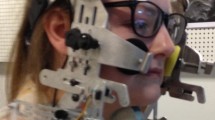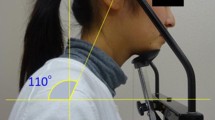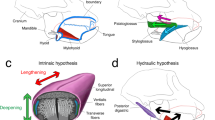Abstract
Six female adults were studied during the production of four single swallows each, using real-time ultrasound. A pellet was affixed to the tongue at the junction between the (calculated) anterior third and posterior two-thirds of the tongue surface. Direction, rate, and extent of pellet movement were measured and used to create stages of tongue blade movement during swallowing. Pellet movement was then compared to the three stages of hyoid movement (ascent, steady, descent). Anterior-posterior and superior-inferior components of pellet movement were examined and discussed.
Similar content being viewed by others
References
Ekberg, O., and G. Nylander, 1982. Cineradiography of the pharyngeal stage of deglutition in 150 individuals without dysphagia.Br J Radiology 55:253–257.
Franks, H., A. Crompton, and R. German, 1984. Mechanism of intraoral transport in macaques.Am J Phys Anthropology 65:275–282.
Franks. H., R. German, A. Crompton, and K. Hiiemae (in press). Mechanism of intraoral transport in a herbivore, the hyrax, (procavia syriacus).Arch Oral Biology.
Fujimura, O. 1981. Temporal organization of articulatory movements as a multidimensional phrasal structure.Phonetica 38:66–83
Hashimoto, K., and K. Sasaki, 1982. On the relationship between the shape and position of the tongue for vowels.J Phonetics 10:291–299.
Kiritani, S., K. Itoh, and O. Fujimura, 1975. Tongue-pellet tracking by a computer controlled x-ray microbeam system.J Acoustical Soc Am 57:1516–1520.
Logemann, J. 1983.Evaluation and treatment of swallowing disorders. San Diego: College Hill Press.
Shawker, T., B. Sonies, and M. Stone, 1984. Soft tissue anatomy of the tongue and flloor of the mouth: An ultrasound demonstration.Brain Lang 21:35–350.
Shawker, T., B. Sonies, M. Stone, and B. Baum, 1983. Realtime ultrasound visualization of tongue movement during swallowing.J Clin Ultrasound 11:485–490.
Shawker, T., M. Stone, and B. Sonies, 1985. Tongue pellet tracking by ultrasound: Development of a reverberation pellet.J Phonetics 13:135–146.
Sonies, B., M. Stone, and T. Shawker, 1984. Speech and swallowing in the elderly.Gerodontology 3:115–123.
Sonies, B., K. Morrish, L. Parent, and B. Baum, 1985. The effects of age on the oral phase of swallowing. Presented at the NIH Conference on Clinical Research Issues in Swallowing and Swallowing Disorders, Bethesda, MD, June 6–7, 1985.
Stone, M., B. Sonies, T. Shawker, G. Weiss, and L. Nadel, 1983. Analysis of real-time ultrasound images of tongue configuration using a grid digitizing system.J Phonetics 11:207–218.
Yotsuya, H., K. Nonaka, and I. Yoshinobu, 1981. Studies on positional relationships of the movements of the pharyngeal organs during deglutition in relation to the cervical vertebrae by x-ray TV cinematography.Bull Tokyo Dental Coll 22:159–170.
Author information
Authors and Affiliations
Rights and permissions
About this article
Cite this article
Stone, M., Shawker, T.H. An ultrasound examination of tongue movement during swallowing. Dysphagia 1, 78–83 (1986). https://doi.org/10.1007/BF02407118
Issue Date:
DOI: https://doi.org/10.1007/BF02407118




